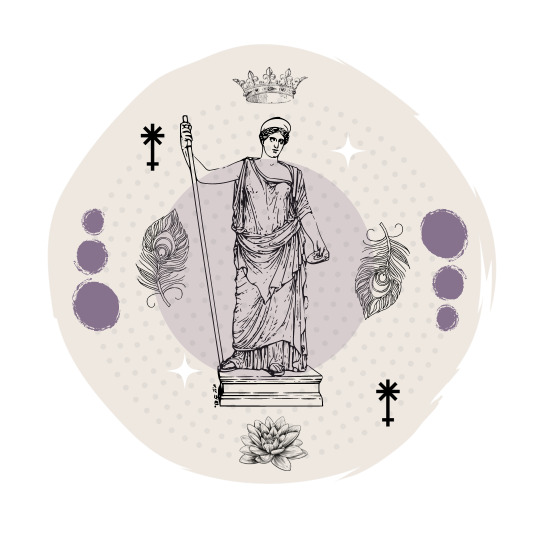apollo devotee and worshipper of hermes, aphrodite and zeus, diviner, witch. i'm aquiles!
Don't wanna be here? Send us removal request.
Text
7 Virtues of Hellenism.
Xenia - This is the pillar that signifies hospitality, generosity and reciprocity. It's typically demonstrated in a guest/host dynamic.
Kharis - This is the pillar that signifies appreciation and gratitude. It entails giving to the gods and and expressing gratitude when you receive something from them.
Eusebia - This is the pillar that signifies reverence and veneration towards the gods. It can be translated to 'piety' or 'reverant conduct' meaning that you show respect for them.
Hagneia - This is the pillar that signifies purifying yourself. It entails having moral, perhaps physical too, purity and avoiding miasma where possible.
Arete - This is the pillar that signifies excellence and brilliance. It entails trying to reach your highest potential and this can be in any field.
Sophia - This is the pillar that signifies the pursuit of knowledge and wisdom.
Sophrosyne - This is the pillar that signifies self-control and prudence. It involves being of sound mind and remaining balanced, which can further lead to other positive qualities to have.
I hope these are right and that I didn't misunderstand their meanings! Hopefully this is useful to anyone, I certainly enjoyed making the post!
3K notes
·
View notes
Text
Prayer to Hekate
I call to you, kind Hecate, watchful daughter of far-seeing Asteria,
Torch-bearing goddess, night-wanderer, pale and fair as the moonflower.
Hekate of the three ways, goddess of the crossroads, keen-eyed one, you see clearly what others overlook.
Hekate of the three realms, goddess who holds a stake in all the worlds, all within are yours to stir.
Gentle of touch and firm of hand, Hekate, leader of the ghostly train, the barking of dogs marks your passage, the shining of stars lights your path.
Hekate who is the companion of those who walk the bounds of light and dark, I praise and honour you.
379 notes
·
View notes
Text
Resources for Hestia Devotees
Hestia, virgin goddess of the hearth, home, and sacrificial fire. Formal Pronunciation: EH-stee-uh [source]
The only traditional epithets:
(1) Boulaia = “of the council”.
(2) Prytaneia = “of the Prytanis.”
Modern/UPG epithets
Resources:
Theoi.com
On what she presides over and sacred symbols
On first and last born
On Hestia abdicating to Dionysus
Hestia followers on tumblr
Helpful links:
On introducing yourself
Bedridden devotion to Hestia
Bedridden Hestia altar
Altar ideas: here / here
Devotional acts/honoring her: here / here / here / here
Morning ritual
Offering ideas: here / here
Crystals associated with her (UPG)
Ways to honor Hestia this holiday season
Flameless hearths and devotions
Prayers:
Historical prayer to Hestia
Guide the lost and those who have nothing
For mental strength
Strength in mental illness
For comfort and self love
For generosity and love
Guidance through hardship
May you always find a home
Helper of the homeless
Morning and evening prayer
Morning and night prayer
Hymn/prayer for prayer beads
Tea prayer/blessing
House blessing
Kitchen prayer
Devotionals and Hymns:
Patron of hometowns
Seeking guidance on paths
Helper of the homeless
Patron goddess
Hail Hestia
Hestia
To Hestia
Hestia’s home
Hymn to Hestia
Orphic hymn 84
Holy hearth flame
Hymn to Hestia-of-the-Cabled-Cardigan
Sigils and Emoji Spells:
My relationship with Hestia is strong (sigil)
My connection to Hestia is strong (sigil)
Sospidonum (sigil)
Hestia (sigil)
Emoji prayer to Hestia
To make your house a home (emoji spell)
Heal your heart and spirit (emoji spell)
Warm your heart and soul (emoji spell)
To feel connected to Hestia (emoji spell)
Updated 10/10/19
2K notes
·
View notes
Text
I'm a Hellenic polytheist and Demeter is one of my primary deities. And here's the thing so many modern interpretations of Demeter misconstrue -

In ancient Greek religion, the worship of Persephone was inextricably linked to the worship of Demeter; especially in their mystery cult at Eleusis, you would not see one honoured without the other. Modern interpretations have made Demeter out to be the overbearing protective mother, but this underestimates her nature as a grieving mother, one of the eldest of the Olympians.
Those who've read source texts such as the Homeric hymn to Demeter know she is a goddess of death as much as a goddess of life. One of her epithets is Chthonia - of the earth, a title shared by other chthonic deities like Nyx and Hekate.
Demeter is a harvest goddess, but just as her daughter Persephone embodies both life and death, so too does Demeter hold lives in her hands through the bringing of the seasons, the withering of crops.
She is a mother - one of the initiation rites to the Eleusinian mysteries was ritual bathing in a river, the salt water symbolizing Demeter's womb waters. It was her love and desperation for Persephone's return that caused the crops to fall to frost. Their relationship is central to their worship, and in the ancient Hellenic view, crucial to human survival.
You can read about Demeter's myths and epithets here.
215 notes
·
View notes
Photo
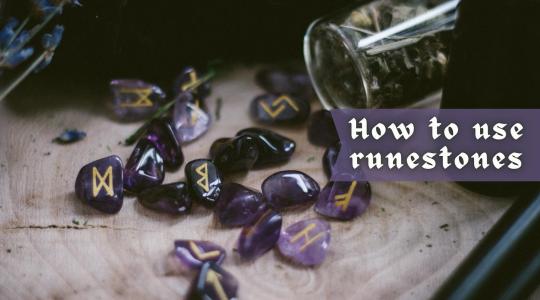
A Complete Guide to Runestones
Casting and reading the runes is a popular form of divination in modern new-age practice. It is based on an old Germanic and Norse practice linked with the practice of Heathenry and the worship of Odin and other northern European pagan gods.
Like many other forms of divination, the practice is designed to help you access your intuition or your spiritual senses to bring to the surface truths that you already know in your heart. Your subconscious mind is much more powerful than your conscious mind and has information you simply cannot take in consciously. Practices such as rune casting let you quiet the conscious mind so that your subconscious mind has space to speak and reveal.
You can read more about the underlying philosophy of divination in our post about using the Tarot.
In this article, we will take you through several methods for casting rune stones for divination and how to interpret the runes. At the end of the article, we will also take a closer look at the history of the runes from ancient times to modern practice.
How to Read the Runes
Since rune casting is all about tapping your intuition and divine spark, there is no single right way to use them. Many experienced rune readers have developed their own approaches and shared them, so look around for ideas and inspiration.
But any approach will involve holding a question in your mind and then casting, placing, or selecting stones that will guide you toward a response.
Before you start, there are a few steps that you should take.
Find a set of runestones that speaks to you spiritually – you can shop our runestone collection here.
Connect with your rune stones by spending time with them. This should be physical, holding them in your hands and examining them, and intellectual, reading your guidebook and taking in the meanings associated with the different runes.
Prepare yourself through meditation that helps you to quiet your active mind and let your subconscious mind flow to the surface.
Learn how to ask questions, which should be open-ended, since all things are possible, rather than yes or no questions.
Read our more detailed guide to preparing for a divination session here.
Before every individual casting, you should also cleanse your rune stones of energy other than your own. You can protect your rune stones by storing them with energy-cleansing crystals such as black obsidian, citrine, or amethyst. You can also cleanse your cards by leaving them under the light of the moon for a night or smudging them with incense. You should then hold the runestones in your hands for several minutes before a reading to make a connection between yourself and the runes.
Casting Patterns and Methods
There are many different ways to then use the runes to find answers, but we will go through some of the simplest and our favorites below.
The Three Norns
Hold your runestones while considering your question, and then retrieve the rune stones that seem right either from your hands or from a sack. Place three runestones in a row in a horizontal line. The first runestone will reveal the major causes of your current challenges. The middle stone will represent the reality of your current situation, which we are often blind to. The final runestone will indicate the best course of action going forward.
The Four Dwarves
This casting works in the same way, except that you will place four runestones in a circle, working clockwise from the top. The top rune indicates the main causal factors of your situation. The runestone on the right suggests that you are doing that is influencing the current situation, while the left indicates what others might be doing or feeling. The bottom runestone indicates the reality of what is happening that is currently hidden from you.
Vé Branches
This is a more complex casting that uses seven runestones laid out in a V shape. Start with the bottom rune and work upwards, placing runes on the right and then the left. The rune at the bottom represents the truth of your current situation, and each line represents one of the most likely outcomes. The first rune represents your most likely action, the second your motivation for that action, and the third what the result is likely to be.
Rune Board
Other casters use a rune board. This can be designed in various ways but will have different areas that relate to different elements. It could be past-present-future, cause-affect-outcome, or different aspects of your personality. In this case, when you are ready to ask your question, you throw the runes over the board and make your reading based on where they land.
Individual Rune Meanings
There are many different rune designs, and each will come with its own guide with different meanings and interpretations. Also, as you become accustomed to the runes and grow close to them, you will start to develop your own meanings and associations.
Nevertheless, below are the most commonly accepted meaning for the Armanen runes, the runes most commonly used in rune casting.
Fa – Primal Fire – power of spirit, change, and creativity
Ur – Resurrection – physician’s rune for resurrection, eternity, and continuity
Dorn – Lightning and Thunder – targeting goals, activity, masculinity
Os – Mouth – spiritual power, voice, gaining power and respect
Rit – Ritual – orderliness, primal law, cynical events, rescue from an enemy
Ka – World Tree – power, generation, ability, and artfulness
Hagal – Hail – mother rune represents enclosure and contains potential for growth
Not – Necessity of Fate – karma, future existence
Is – Ego – self-control, personal power, obedience, compelling will
Ar – Leadership – beauty, fame, intelligence, virtue
Sig – Sun Power – success and victory
Tyr – Rebirth of the Sun God – turn a situation around, wisdom, spiritual understanding
Bar – Birth – creative power, becoming, song
Laf – A-rlog – defeat, laws or nature, water
Man – Manking – birth, health, increase, maleness
Yr – Bow – femaleness, nigh, death, instinct, anger, falsehood
Eh – Duality – love, trust, and marriage
Gibor – Gift of Life – cosmic consciousness and divine principle
Where do the Runes come from?
Various northern European peoples used runes as a system of writing. Probably the most widespread runic language was Futhark, used by the Norse people. They used a 24-character alphabet known as Elder Futhark between the 2nd and 8th centuries, which developed into a smaller 16-character alphabet known as Younger Futhark from the 8th century. At around the same time, the Anglo-Saxons and Frisians developed a related Runic alphabet known as Anglo-Saxon Futhorc.
Across all these groups, the runes became less popular with the rise of Christianity, and they were replaced by the Latin alphabet.
The Norse people believed that their runes were more than just a system of writing but rather a tool used to shape reality. The Norns, the fates in Norse mythology, write destiny into the bark of Yggdrasil using the runes. Odin, the most important Norse deity, saw the Norns at their work and was jealous of their knowledge. He hung himself from the World Tree, Yggdrasil, for nine days and nine nights while pierced by his own sword to learn the secrets of the runes, which he then shared with mankind.
In the Norse sagas, many heroes are described as runemasters who can use the runes to heal the sick and destroy their enemies. There are also many surviving archaeological examples of objects inscribed with runes seemingly meant to provide protection or ensure the quality of something stored. But, since the pagan Norsemen left no written records and our knowledge principally comes form later Christain texts, we do not know very much about how the Vikings used the runes.
We do know that centuries later, the Norse people of Iceland combined the runes to create runic staves believed to have magical properties. These are recorded in several magical grimoires surviving from the 17th, 18th, and 19th centuries. Some of the most famous runic staves in these magical texts include Aegishjalmur, also known as the Helm of Awe, a symbol of protection, and Vegvisir, also known as the Norse Compass, a powerful wayfinding symbol.
Ancient to Modern Runic Divination
We know that the Norsemen also engaged in divination. Volva were witch women highly respected in society that were often called upon to act as seeresses. That their practices may have included rune casting is indicated by a much older text.
The first-century Roman author Tacitus observed similar witches among the Germanic tribes of his day. He said that the runes were carved into small objects, such as sticks and bones, which would then be cast onto the ground. The seeress would make a reading based on how the runes fell.
But while runic divination seems to have existed in some form for at least 2,000 years, the modern practice dates to the 17th century. Johannes Bureus, a Swedish mystic, was inspired by the practices of his ancestors and made the modern system based on combining the Younger Futhark runes with the Kaballah, a Jewish mystical tradition.
His work was further developed in the 1900s by the Austral occultist Guido von List. This is the most common system used today and is known as the Armanen runes.
[Read The Full Blog Post Here]
987 notes
·
View notes
Text
I’m writing smthn and my favorite lines so far are:
For Artemis:
“She speaks to us, her words soft on the wind.”
“She has no children, but she is a mother at her core, protective and caring.”
“She dances under the light of the moon, laughing with her brother until the sun begins to rise.”
For Apollo:
“He protects his sister and mother with a golden ferocity.”
“His arrows shine silver on his back, a threat against scorn.”
For Ares:
“He watches as soldiers go into battle, protecting them as they fight; and their family after they fall.”
For Hephaestus:
“He marvels at our creations, cracking a smile at our architecture and art.”
“We build and build. We reach for the sky, though we are grounded.”
For Hermes:
“Hermes is alive in the wind, in laughter.”
“He’s there in the freedom of travel and the exhilaration of running.”
“He’s been to every corner of the earth, yet he still runs. Things are changing, and he wants to see it all.”
“He has hope. He never stopped having it.”
For Hestia:
“Home is warm. Home is safe. She will fight to keep it that way.”
“She holds Demeter as she sobs, yearning for a daughter just out of reach.”
“She welcomes Hermes home with a smile, knowing he’ll be gone by morning.”
“This is her family, and she will protect it.”
There’s a lot more, but I picked some of my favorite lines out. I’m editing rn and I’ll probably post the finished product!
41 notes
·
View notes
Text
Artemis Devotional Activities

𝐀𝐬 𝐩𝐞𝐫 𝐫𝐞𝐪𝐮𝐞𝐬𝐭, 𝐡𝐞𝐫𝐞 𝐢𝐬 𝐚 𝐥𝐢𝐬𝐭 𝐨𝐟 𝐝𝐞𝐯𝐨𝐭𝐢𝐨𝐧𝐚𝐥 𝐚𝐜𝐭𝐢𝐯𝐢𝐭𝐢𝐞𝐬 𝐟𝐨𝐫 𝐀𝐫𝐭𝐞𝐦𝐢𝐬 ! 𝐓𝐡𝐞 𝐥𝐢𝐬𝐭 𝐢𝐬 𝐧𝐨𝐧 𝐞𝐱𝐡𝐚𝐮𝐬𝐭𝐢𝐯𝐞 𝐬𝐨 𝐟𝐞𝐞𝐥 𝐟𝐫𝐞𝐞 𝐭𝐨 𝐭𝐡𝐢𝐧𝐤 𝐚𝐛𝐨𝐮𝐭 𝐡𝐞𝐫 𝐝𝐨𝐦𝐚𝐢𝐧𝐬, 𝐡𝐨𝐰 𝐭𝐡𝐞𝐲 𝐜𝐨𝐧𝐧𝐞𝐜𝐭 𝐭𝐨 𝐲𝐨𝐮𝐫 𝐥𝐢𝐟𝐞, 𝐚𝐧𝐝 𝐠𝐞𝐭 𝐜𝐫𝐞𝐚𝐭𝐢𝐯𝐞 !
𝚃𝚊𝚔𝚒𝚗𝚐 𝚌𝚊𝚛𝚎 𝚘𝚏 𝚊𝚗𝚒𝚖𝚊𝚕𝚜
She is called the Mistress of Animals, they are under her protection which mean that learning from her and try to do the same is a great devotional activity. There are many ways to go about it: you can spend time bonding with your pet(s); you can take care of the wildlife outside your home, for example by making sure animals have space to seek shelter in your garden, or to leave water to birds in summer; volunteering at an animal shelter or alternatively; donating to said animal shelter or to any organization that takes care of animals.
𝙷𝚞𝚗𝚝𝚒𝚗𝚐
This isn’t going to be doable for 99% of people reading this but I thought I should mention it anyway.
Seems in total contradiction with the idea of taking care of the animals, right? Well, there are different ways to hunt and they aren’t all equal. It is important to know that in some areas of the world, such as Europe were I live, the big predators have pretty much been exterminated so deer and boars have no threat and are free to multiply, which is a problem for the forests and the fields they damage.
Which is why controlled hunting is a good way to regulate the populations, but also to provide local meat that seems less cruel than breeding animal in cages for all their life…
However, not all methods of hunting are equal! Like hunting with hounds (chasse à courre in french) or putting glue on trees so that birds can’t fly away like they do in France is horrible and in my opinion shouldn’t be practiced!
𝙶𝚎𝚝 𝚒𝚗 𝚝𝚘𝚞𝚌𝚑 𝚠𝚒𝚝𝚑 𝚗𝚊𝚝𝚞𝚛𝚎
This will highly depend on where you live and the level of nature that is available to you, so it might be a challenge to try to feel in touch with the wilderness if all that’s around you is concrete… if you have the opportunity to though, taking a walk or hiking in nature, hear the birds, touch the soil, feel the trees, try to reach for that pockets of wild free energy that’s buried within.
I think trying to understand what ties you to nature, how you are a part of it, is really beautiful and important and a way to connect to the goddess.
𝚂𝚞𝚙𝚙𝚘𝚛𝚝 𝚝𝚑𝚎 𝚙𝚛𝚘𝚝𝚎𝚌𝚝𝚒𝚘𝚗 𝚘𝚏 𝚝𝚑𝚎 𝚎𝚗𝚟𝚒𝚛𝚘𝚗𝚖𝚎𝚗𝚝
Obviously an important topic to all the theoi due to the humans endangering other species and their own with their actions, but Artemis as a deity of nature cares especially about that. Act, vote, work, or donate would be really great depending on what you can do. I was also thinking that topics such as making sure there are pockets of nature even within cities, such as parks where areas are left ‘‘untamed’‘ to allow insect and birds to thrive would be a really cool project. Go wild.
𝚃𝚊𝚔𝚒𝚗𝚐 𝚌𝚊𝚛𝚎 𝚘𝚏 𝚌𝚑𝚒𝚕𝚍𝚛𝚎𝚗
She famously helped her mother Leto to birth her brother Apollo, so if that’s your job too, cool ! If not, you can always spend some time with children and care for them and their mother. Alternatively, volunteering time or donating money to an organization (ex: UNICEF) that focuses on the protection children is great too.
𝙴𝚍𝚞𝚌𝚊𝚝𝚒𝚗𝚐 𝚌𝚑𝚒𝚕𝚍𝚛𝚎𝚗/𝚝𝚎𝚎𝚗𝚜
Artemis would be with the children/teens up until they married, she is thus connected to education and crossing important boundaries and life cycles. I got the idea that writing a book for children, teaching them about the environment or sex education or whatever, would be a great way to care for them and become balanced, functioning adults. You can expand on this idea and try to think of how to educate the children/teens around you. Doesn’t need to be something big, can be as simple as showing them how the nature around them works.
𝙻𝚎𝚊𝚛𝚗𝚒𝚗𝚐 𝚝𝚘 𝚜𝚝𝚊𝚗𝚍 𝚞𝚙 𝚏𝚘𝚛 𝚢𝚘𝚞𝚛𝚜𝚎𝚕𝚏
Artemis is a free spirited goddess who lives a very different life from what’s expected of a woman of her time, so to me she is a role model of standing up for yourself. Doesn’t mean that you need to swear off relationships and go live in the woods with your gal pals ! To me it means learning who you are, deeply, knowing what are your boundaries, what you truly want, and make people respect that.
She is a never ending source of inspiration to me when I think of how fierce and strong she is and I see working on myself to reach that as a devotional act.
𝚂𝚞𝚙𝚙𝚘𝚛𝚝 𝚙𝚎𝚘𝚙𝚕𝚎 𝚝𝚘 𝚕𝚒𝚟𝚎 𝚝𝚑𝚎𝚒𝚛 𝚘𝚠𝚗 𝚝𝚛𝚞𝚝𝚑
Following the same idea, honoring other people’s truth and identity, respecting other people difference even, and especially, if they are different from yours of if you don’t really get them, is a way to respect their own power over themselves. In doing so, you not only honor them but you also honor yourself.
𝙼𝚊𝚔𝚎 𝚊𝚛𝚝
All the deities enjoy the arts that is being made in their honor and Artemis is no exception. So use whatever skills you have and get creative !
𝙳𝚊𝚗𝚌𝚎
It’s a side of her that isn’t talked about very much but Artemis is indeed connected to dancing and it is thus a perfect devotional activity ! take some time out of your day to really get in touch with your body, loosen up, get lost in the music, let your body express itself, in group or alone!
281 notes
·
View notes
Text
A guide to worship of Artemis- cheat sheets

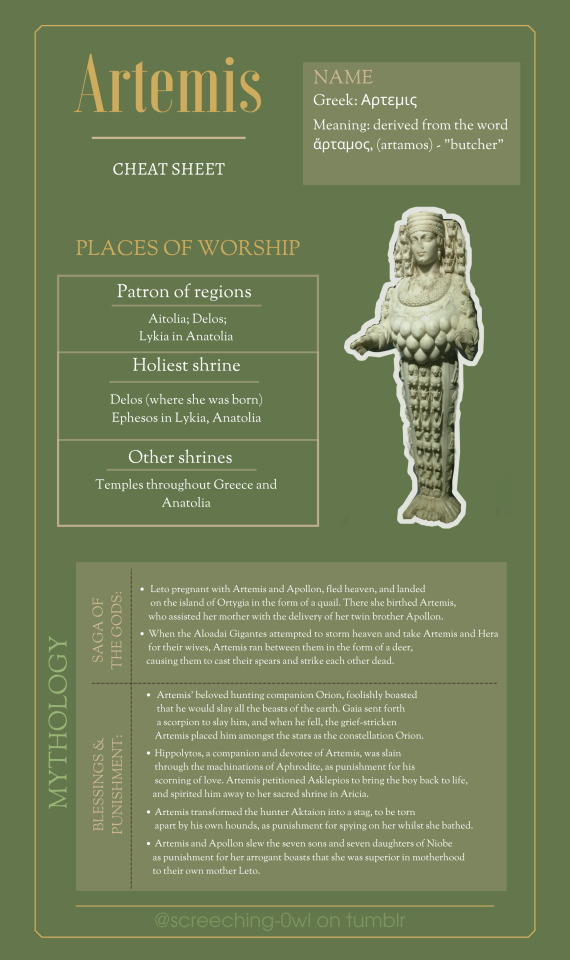


Hellenic cheat sheets
If you like my content consider supporting me on: https://ko-fi.com/screeching0wlet
2K notes
·
View notes
Text
A guide to worship of Nemesis - cheat sheets


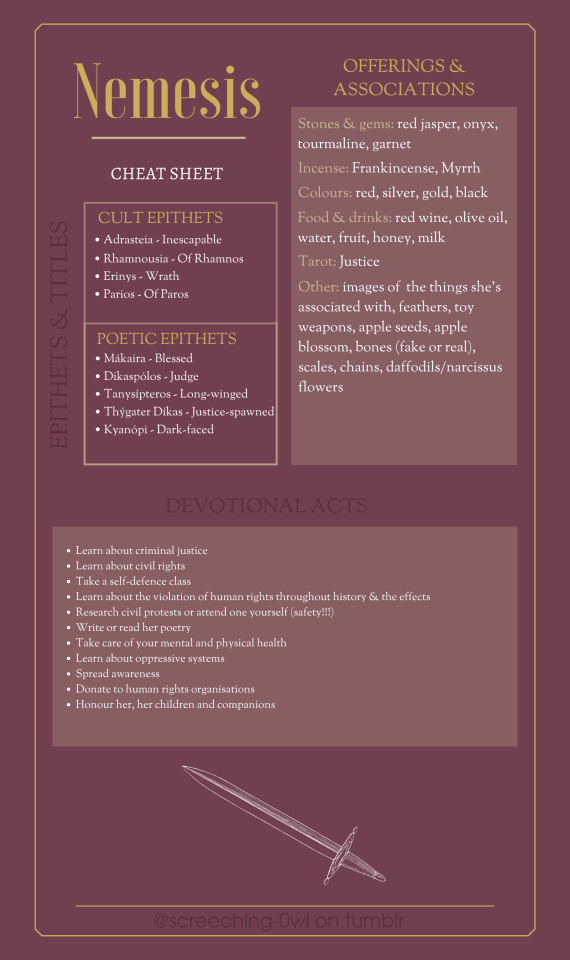
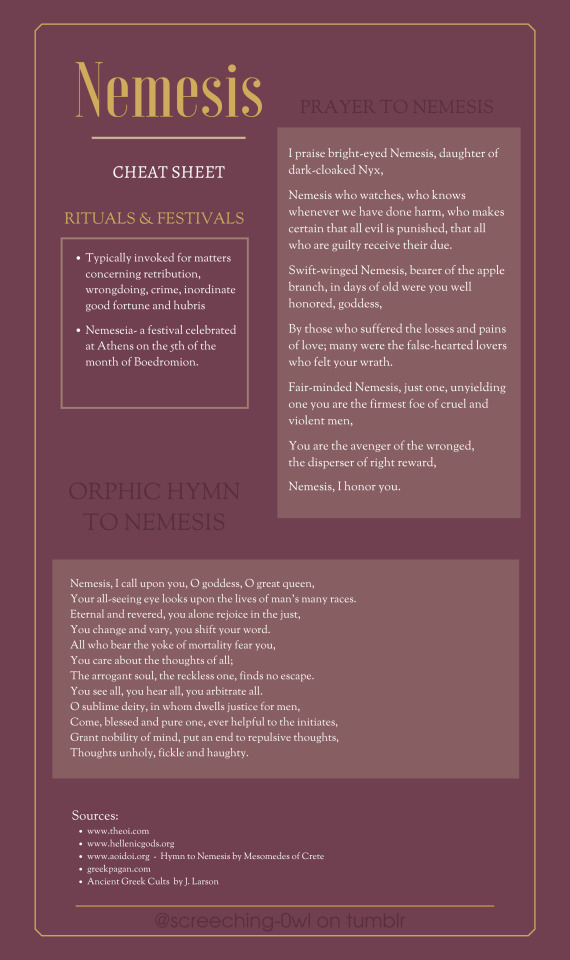
Hellenic cheat sheets
If you like my content consider supporting me on: https://ko-fi.com/screeching0wlet
495 notes
·
View notes
Photo

Evelyn Pickering De Morgan, Demeter Mourning for Persephone, 1906
254 notes
·
View notes
Photo

— to you, o king of power & might, to you, o lord father zeus, do i sing. i give worship to the strength of you, the power that rings and echoes within my very bones. o lord of the heavens, lord of the earth, lord of all that dwells within, to you i sing. illuminate the dark where my feet tread, your strike of lightning to chase away the foes before me. out of chaos, o mighty king, led me forward. guide me in righteous ways, bring holiness to my words, & lend me your strength. o blessed king! ruler of all the gods!— king of glory & brightness! it is to you that i sing —
487 notes
·
View notes
Text
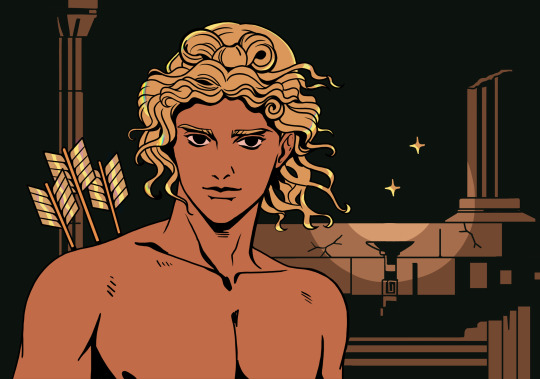

light in the dark
1K notes
·
View notes
Text
The Virgin Mary,
a masterpost

Table of contents:
• Intoduction; many names, one Mother
• Mary in Christianity
• Mary in Islam
• Marian Devotion
• Hyperdulia; to love Our Mother
• Attributes of Mary
• Mary's Patronage
Introduction; many names, one Mother
Mary, Mother of Jesus but also מרים, [Myrhiàm] in hebrew, Maryām in aramaic, Μαριάμ [Mariam] or Μαρία [María] in greek and مريم [Maryām] in arabic is, in the gospels of Matthew and Luke in the New Testament, Mary was a first-century Jewish woman of Nazareth married to Joseph. In both the New Testament and the Quran she is described as a virgin. In Christian theology, Mary conceived Jesus through the Holy Spirit while still a virgin, and accompanied Joseph to Bethlehem, where Jesus was born.
Mary has been venerated since early Christianity, and is often considered to be the holiest saint because of her extraordinary virtues. She is said to have miraculously appeared to believers many times over the centuries. The Eastern and Oriental Orthodox, Catholic, Anglican, and Lutheran churches believe that Mary is the Theotokos (Θεοτόκος). There is significant diversity in the Marian beliefs and devotional practices of major Christian traditions. The Catholic Church holds distinctive Marian dogmas, such as: her status as the Mother of God, her Immaculate Conception, her perpetual virginity, and her Assumption into heaven.
Also, according to Catholic and Eastern Christian teachings, at the end of her mortal life, God raised Mary's body into heaven; this episode is called the Assumption of Mary.
Mary In Christianity
In Christianity, she is referred to as the Virgin Mary, in accordance with the belief that the Holy Spirit impregnated her, thereby conceiving her son Jesus miraculously, without sexual relations with her husband Joseph, "until her son [Jesus] was born". Among her many other names and titles are the Blessed Virgin Mary (abbreviated: "BVM", or "BMV" after the Latin "Beata Maria Virgo"), Saint Mary (occasionally), the Mother of God (In Western Christianity), Theotokos (in eastern Christianity), Our Lady (Medieval Italian: Madonna), and Queen of Heaven (Regina caeli), although the title "queen of heaven" was for centuries before used as an epithet for a number of ancient sky-goddesses, such as Nin-anna, Astarte, Ishtar and Astoreth.
Of course, titles in use vary among Christian denominations.
The three main titles for Mary used by the Orthodox are Theotokos (Θεοτόκος or loosely "Mother of God"), Aeiparthenos (ἀειπαρθὲνος) which means ever-virgin, and Panagia (Παναγία) meaning "all-holy".
Catholics use a wide variety of titles for Mary. For an instance, "Our Lady of Sorrows"
The title "Theotokos" was recognized at the Council of Ephesus in 431. The Latin equivalents are Deipara and Dei Genitrix, although the phrase is more often loosely translated into Latin as Mater Dei. However, this same phrase in Greek (Μήτηρ Θεοῦ), in the abbreviated form 'ΜΡ ΘΥ', is an indication commonly attached to her image in Byzantine icons.
Some Marian titles have a direct scriptural basis. For instance, the title "Queen Mother" has been given to Mary, as she was the mother of Jesus, sometimes referred to as the "King of Kings" due to his ancestral descent from King David. Other titles have arisen from reported miracles, special appeals, or occasions for calling on Mary.
Mary in Islam
In Islam, Mary is the mother of Isa (عيسى بن مريم). She is often referred to by the title "Sayyidatuna", meaning "Our Lady"; title that is in parallel to "Sayyiduna" that can be translated as "Our Lord" and that is used for the prophets. A related term of endearment is "Siddiqah", meaning "she who confirms the truth" and "she who believes sincerely completely". Another title for Mary is "Qānitah", which signifies both constant submission to God and absorption in prayer and invocation in Islam. Mary is also called "Tahira", meaning "one who has been purified". Mary also has the highest position in Islam among all women. She is mentioned in the Quran more often than in the Bible, where two of the longer chapters of the Quran are named after her and her family; namely in the Sūra III "Āl ʿImrān" and in the Sūra XIX "Maryam".
Marian Devotions
The term "devotions" is commonly understood to refer to those external practices of piety by which the faith of an individual finds expression. Such prayers or acts may be accompanied by specific requests for Mary's intercession with God.
Devotion to the Virgin Mary does not, however, amount to worship – which is reserved for God. (This part will be explained more in dept futher)
A wide range of Marian devotions are followed by Catholics from the simple Rosary recitations to maintaining a Mary garden. Two well known Marian devotions are the Rosary recitation and the wearing of the Brown Scapular. Following their joint growth in the 18th and 19th centuries, by the early 20th century the Rosary and the devotional Scapular had gained such a strong following among Catholics worldwide that the Catholic Encyclopedia of 1914 stated: "Like the Rosary, the Brown Scapular has become the badge of the devout Catholic."[138] In his encyclical Rosarium Virginis Mariae Pope John Paul II emphasized the importance of the Rosary. The Mariological basis of the Scapular devotion is effectively the same as Marian consecration, as discussed in the dogmatic constitution Lumen gentium of the Second Vatican Council, namely the role of the Virgin Mary as "the mother to us in the order of grace" which allows her to intercede for "the gift of eternal salvation". The same Council decree clarified that the many ways in which Mary can encourage and assist us "neither takes away from nor adds anything to the dignity and efficaciousness of Christ the one Mediator."
Roman Catholic tradition includes specific prayers and devotions as Acts of Reparation to the Virgin Mary for insults that she suffers. The Raccolta Roman Catholic prayer book (approved by a Decree of 1854, and published by the Holy See in 1898) includes a number of such prayers. These prayers do not involve a petition for a living or deceased beneficiary, but aim to repair the sins of others against the Virgin Mary.
Hyperdulia; to love Our Mother
l'iperdulìa (from the greek: ὑπερδουλεία, composed by ὑπέρ, /hyˈper/, and δουλεία; which means «more than dulia») and its a form of reverence reserved to Our Lady, which, as stated in the very own term — is superior to the dulia given to other saints, which is considered inferior. Hyperdulia is an intermediate kind of reverence that is above dulia and under Latria, which is adoration and is only reserved to the Almighty.
Attribubutes of Mary
The attribute of Mary are:
Blue mantle
crown of 12 stars
pregnant woman
roses
woman with child
woman trampling serpent
crescent moon
woman clothed with the sun
heart pierced by sword
rosary beads
Mary's patronage
Although she is a patroness of all humanity there are occupations that are specifically close to her and some specific titles of hers. Those occupations are:
• Benedictines
• Bicyclists - Madonna del Ghisallo
• Brothers Hospitallers of Saint John of God
• Cistercians
• Fishmongers (Assumption of the Blessed Virgin)
• Overseas Filipino Workers - Our Lady of Guidance
• Harness Makers (Assumption of the Blessed Virgin)
• Seafarers - Our Lady Star of the Sea
• Spanish Civil Guard - Our Lady of the Pillar
• Pilots/Aviators - Our Lady of Loreto
107 notes
·
View notes
Text









Biblical mythology from A to Z:
[V] — Virgin Mary
And the angel answered her, ‘The Holy Spirit will come upon you, and the power of the Most High will overshadow you; therefore the child to be born will be called holy—the Son of God’
230 notes
·
View notes
Text
Zeus is a father God, a paternal figure, he gives comfort, he protects, he provides, he is loving. I'd say "change my mind" but you can't.
424 notes
·
View notes
